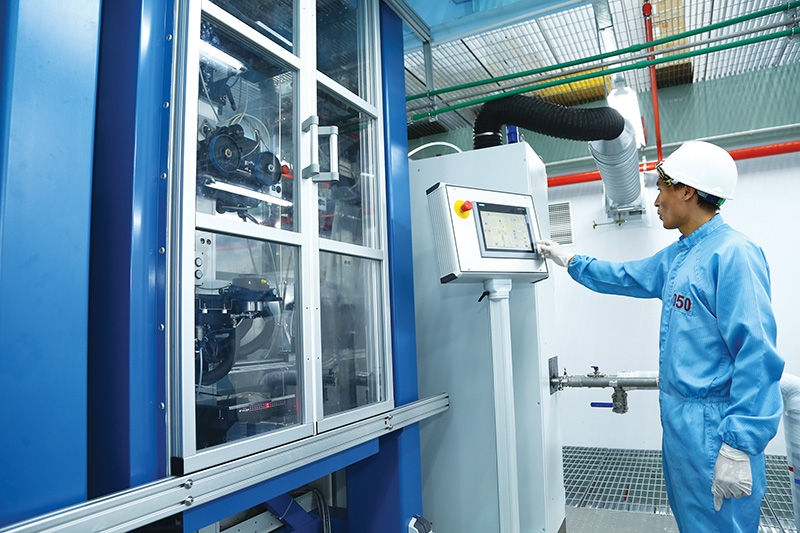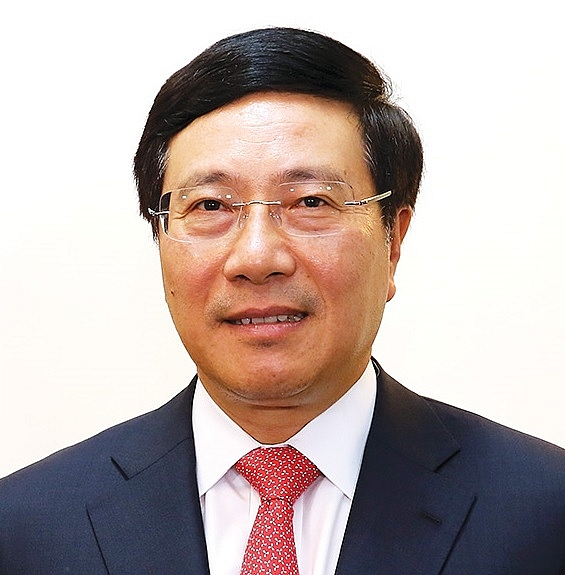Vietnam takes the lead in ASEAN’s digital evolution
 |
| Vietnam is joining hands with regional nations in fostering digital solutions to turn Southeast Asia into an e-region. Photo: Le Toan |
As the entire ASEAN region is seriously hit by the expanding health crisis, member states are discussing possibilities for the regional economy to bounce back strongly, in order to help enterprises and individuals stay afloat.
One of the best solutions is the boosted application of digital technologies and usage of new achievements of Industry 4.0, which according to experts, refers to a set of highly disruptive technologies such as AI, robotics, blockchain, and 3D printing – all of which are transforming social, economic, and political systems while placing pressure on leaders and policymakers to respond.
“Cooperation in digital transformation and digital economy development are not only discussed now, but also at the coming 37th ASEAN Summit in Vietnam later this year,” said an official from the Ministry of Foreign Affairs. “With its great potential in IT, Vietnam is sharing experiences and also learning lessons from other regional nations to develop itself into a veritable digital economy and the ASEAN into a big digital economy. This will help the ASEAN address emerging challenges.”
For example, Vietnam is seeking experience from Indonesia in digitalisation and how to enact relevant policies.
In 2017, Indonesia began to embrace Industry 4.0 in order to turn itself into one of the 10 biggest economies globally by 2030. Its government has selected five key sectors for the initial adoption of Industry 4.0: food and beverages; textiles and clothing, automotives, chemicals, and electronics.
“These sectors would need a very high digitalisation level in the future, and they are the biggest contributors of Indonesia’s economy,” said Indonesian Ambassador to Vietnam Ibnu Hadi.
Currently Southeast Asia has 10 unicorns with over $1 billion in valuation each – Gojek, Tokopedia, Traveloka, Bukalapak, Lazada, Revolution Precrafted, Grab, Sea (Garena), Razer, and VNG. However, four of which come from Indonesia, including ride-hailing company Gojek, online travel agent Traveloka, e-commerce platform Tokopedia, and e-commerce platform Bukalapak. Vietnam has only one, namely game developer VNG.
Winning global applause
Vietnam’s efforts to develop a pro-business e-government and a digital economy have received applause from the international community, especially amid a surge in the pandemic hurting economic growth.
Under the UN’s Department of Economic and Social Affairs’ newly-launched hallmark E-government Survey 2020, Vietnam has climbed two places to rank 86th out of 193 countries. With this ranking, Vietnam has maintained its record of consecutive increases since 2014, climbing from 99 to 86 in the process.
Harvesting 0.6667 points in the survey’s E-Government Development Index (EGDI), Vietnam is among the e-government developing countries with a high index, a score which is higher than the global EGDI average of 0.5988 points, the Asian average of 0.6373 points, and the Southeast Asian average of 0.6321 points.
In Southeast Asia, Vietnam has successfully maintained the same position as in 2018, ranking sixth among 11 countries, behind Singapore, Malaysia, Thailand, Brunei, and the Philippines.
“Vietnam’s tax authority has deployed e-filing, e-payment, and e-customs initiatives that have helped to improve tax collection and management and have lowered taxpayers’ compliance costs,” the survey’s report cited.
Commenting on Vietnam’s efforts to develop a digital economy amid the trend in the region, Deputy Foreign Minister Bui Thanh Son said, “Vietnam is striving for sustainable growth on the basis of improving the quality of growth and taking advantage of the opportunities of the Industry 4.0 to raise its labour productivity and competitiveness to move up the ladder in the global value chain.”
In Vietnam, about 60 per cent of the 96 million population are under 35 years of age. They have quick access to new technology and about 55 per cent of the population use the internet, he added.
According to Tran Dinh Thien, former head of the Vietnam Economics Research Institute, this potential is quite favourable for Vietnam to build a digital economy successfully and even take the lead in the ASEAN’s digital development. “Vietnam has many opportunities in Industry 4.0. However, the problem now is how to apply lessons from regions such as Indonesia and Singapore to Vietnam and how to integrate data among ministries, agencies, sectors, and individuals into one integrated and shared system,” Thien said.
Fostering digitalisation
According to the World Economic Forum, the ASEAN is the fastest-growing internet market in the world. With 125,000 new users accessing the internet every day, the ASEAN digital economy is projected to grow significantly, adding an estimated $1 trillion to regional GDP over the next 10 years.
Prime Minister Nguyen Xuan Phuc said that the opportunities induced by Industry 4.0 are indeed enormous, and not only Vietnam but also other nations in the region must seize all these opportunities.
“The startup atmosphere is truly permeating throughout the ASEAN,” he said at a meeting with ASEAN leaders.
He suggested a number of priorities for ASEAN nations to grab opportunities from Industry 4.0. The priorities include the regional harmonisation of e-platforms on connectivity in finance, banking, market, communications, and logistics. “I suggest the establishment of a mechanism on harmonising the business climate, legal system, and regulations among ASEAN member states. This will help regional firms to improve their global competitiveness. The ASEAN Single Window – a regional initiative that connects and integrates the National Single Window of ASEAN member states – is a good example,” PM Phuc said.
Envisioning a future defined by Industry 4.0, Vietnamese Minister of Information and Communications Nguyen Manh Hung also underlined the need of ASEAN nations for “smart governance” and the willingness of governments, businesses, and societies to collectively adapt to rapid technological change.
“Technology can change very fast but the people and governments cannot change so fast and this will be our biggest challenge. So what do we need to do?” he said. “We have to train people so they are adept at change, not only technological training, but soft skills too. I think Industry 4.0 is more about a mindset revolution.”
The ASEAN bloc is now jointly boosting the implementation of some new initiatives that Vietnam advanced two years ago in Hanoi, including a “pan-ASEAN roaming charge for mobile phones” initiative, a cybersecurity intelligence cooperation initiative, and an initiative on cooperating in training high-quality IT human resources.
Vietnam also proposed the establishment and connectivity of innovative incubators.
“In the Industry 4.0 context, many ASEAN nations have their own national-level innovation hubs and incubators. And I suggest the construction of a framework on connecting these incubators into a regional-level incubator,” PM Phuc stated.
Meanwhile, Prime Minister of Singapore Lee Hsien Loong also said that Industry 4.0 is opening new prospects to all regional nations which should grab them through proper solutions. “Industry 4.0 is upon us. The global economy is being transformed by new and far-reaching breakthroughs in technologies,” he said. “Here in the ASEAN, member states are in a good position to take advantage of the new opportunities that Industry 4.0 can bring.”
| Pham Binh Minh - Deputy Prime Minister, Minister of Foreign Affairs
When the ASEAN was established 53 years ago, few could have imagined the success of the bloc today. Over the past half-century, the ASEAN has time and again shown the strength of unity and resilience. An ASEAN embracing 10 brotherly nations has turned Southeast Asia from a land of discord to a land of concord, from confrontation to cooperation, and from poverty to dynamic development. Today, the ASEAN Community is a big family of 650 million people with a combined GDP of $3 trillion. Translating its vision into actions, the ASEAN has been promoting both the interest of our peoples and peace and prosperity in the Asia-Pacific. The ASEAN is now at a critical juncture. The new dynamism in our geostrategic landscape, emerging regional and global issues require the ASEAN to be ever more cohesive and responsive. Shoulder to shoulder, we can rise above any challenge and move the ASEAN forward. Therefore, we should redouble our efforts to strengthen our community, while proactively and effectively promoting our ties with partners. We should also ensure an ASEAN-centred regional architecture that is open, transparent, inclusive, and rules-based. This year marks the 25th anniversary of Vietnam’s participation in the ASEAN. Our commitment and experience in the past 25 years enable us to make more proactive contributions. Under Vietnam’s chairmanship this year, a cohesive and responsive ASEAN has taken well-coordinated measures to protect the health of our peoples and revive our economies. The ASEAN has led regional efforts in fighting the pandemic, innovated our operations, and further deepened our external relations. With the “Think Community, Act Community” approach, Vietnam will continue to work closely with our neighbours and friends, to build a strong and united ASEAN. |
What the stars mean:
★ Poor ★ ★ Promising ★★★ Good ★★★★ Very good ★★★★★ Exceptional
 Tag:
Tag:
Themes: Drive ASEAN Forward
Related Contents
Latest News
More News
- Ho Chi Minh City hits $8.37 billion in FDI (December 29, 2025 | 08:28)
- Tax sector wraps up 2025 and sets priorities for next year (December 25, 2025 | 14:00)
- Heavy industries set for pilot greenhouse gas quotas (December 25, 2025 | 10:00)
- $250 million deal targets women-owned SMEs, sustainable agriculture (December 22, 2025 | 17:40)
- UOB sees Vietnam growth easing in fourth quarter (December 22, 2025 | 17:39)
- Government moves to establish International Financial Centre (December 21, 2025 | 21:00)
- Vietnam's IFC to target global investment flows (December 21, 2025 | 18:00)
- Ha Tinh breaks ground on major Vingroup industrial and energy projects (December 19, 2025 | 18:24)
- EVN launches major power infrastructure projects nationwide (December 19, 2025 | 18:17)
- VAL inaugurates second production line to meet domestic animal feed demand (December 19, 2025 | 16:37)
























 Mobile Version
Mobile Version